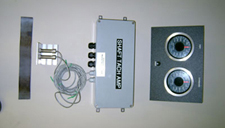REQUEST A QUOTE
CONTACT US
ISO 9001:2015 Certified
Case Studies
Oceangoing Vessel Speed Sensor

For fixed propeller marine vessels, the surest way to determine propeller speed is to measure shaft speed, since the shaft is direct coupled to the engine and has the propeller affixed to it. International Marine Systems in Schriever, LA has developed a unique method to do so which imparts no stresses onto the shaft. “We wrap magnetic tape around the circumference” says Andreas Gottschalk, Engineering Manager of IMS, “then install a magnetic pick-up sensor. When the shaft is spinning, the sensor picks up the alternating (north/south) domains.”
“It creates a sine wave,” continues Gottschalk “when it spins faster the frequency of the wave changes. Our electronics can take the frequency of the wave generated and determine how fast the shaft is moving. In essence we use the tape to interact with the sensor.”
The “tape” is actually a custom designed magnetic sheet with an adhesive back, which is then affixed onto the shaft. The magnetic sheet produced by The Electrodyne Company, has high-energy magnetic fields or stripes within it. The stripes have alternating north and south poles, allowing a magnetic sensor to register the poles as they pass by.
When the shaft is idle, there are no poles passing the sensor. As the shaft begins to turn, the time delay between passings of the poles is measured and indicated. Relatively long time periods between poles equate to slow shaft (and propeller) speed. As the shaft speed increases the time between the passings of poles decreases, indicating faster shaft (and propeller) speeds.
The stripes are spaced just 1/4” wide, providing a continuous stream of speed sensing data. Incorporating high-energy Plastalloy magnetic material, the stripes are easily read by the sensors – even at high rates of speed, and despite the close proximity of the stripes. Skewing of the stripes allows the sensors to determine the direction of the rotation or whether the vessel is going forward or in reverse.
Ken Koch, Marketing Manager of magnetics supplier The Electrodyne Co. recalls the original design. “The original drawing called for a magnetic strip with offset holes to interrupt the magnetic field so that they could determine direction of rotation. We proposed a skewed strip design which is equally effective and much simpler (and more cost effective).”
As important as the determination of speed and direction are, the magnetic “tape” imparts no stress onto the vessels shaft. This was an important consideration for International Marine, since the other options each included some element of stress for the shaft.
Another methodology for measuring shaft speed is to bolt a collar onto the shaft. While less damaging than welding, this methodology still imparts stresses onto the shaft which may manifest themselves at inopportune times, especially for the newer version hollow shafts. Bolt-on collars may employ slightly more targets than weld-on targets, but there are still considerable distances between targets, which correlates directly to poorer speed calculations.
Having equipment and systems that you can take for granted is a good thing to the service technicians maintaining the fleets, and to the captains who rely on the information that the systems provides. After all, when a vessel is miles from port, the captain relies on the shaft’s integrity and on the instruments monitoring it.
About International Marine Systems
International Marine Systems, LLC, is a multi-faceted company catering to the general public and the marine industry specializing in design engineering, manufacturing, and installation of custom control and monitoring systems. IMS utilizes an in-house factory that integrates their components with other manufactured systems, and provides services on these products. IMS also distributes one of the few ABS, DNV, Lloyds and USCG-type approved marine PCs available on the market today. For more information contact Chuck Freeman at (985) 872-9002.

